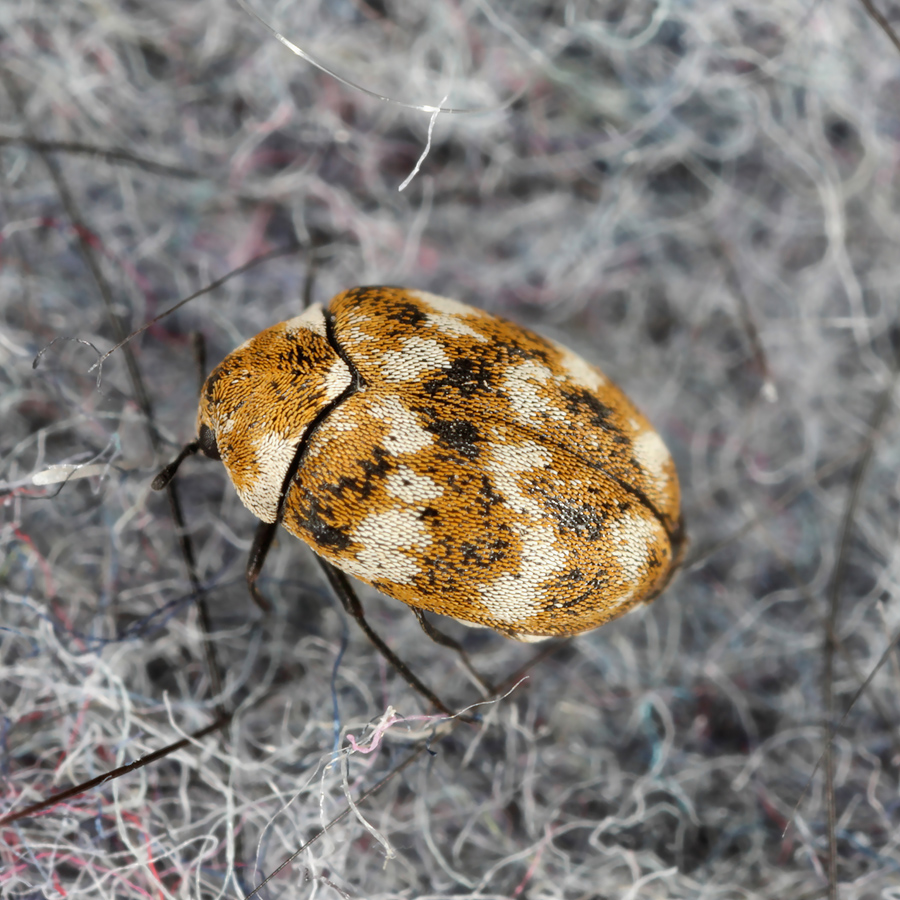You’ve probably landed on this page because you’ve got a concern about carpet beetles.
Maybe they’re infesting in your home.
Or you’re just planning ahead.
Well, you’re in luck, because in this post, we’re giving you some expert info on what carpet beetles are, how to identyfy, prevent or get rid of them. We’ll also look at which materials are more commonly infested.
So, let’s get going.
What are Carpet Beetles?
Carpet beetles are small insects belonging to the family Dermestidae. They are named becuase they infest carpets and other fabric materials in homes. While there are several species of carpet beetles, the most common ones include the varied carpet beetle (Anthrenus verbasci) and the furniture carpet beetle (Anthrenus flavipes).
They feed on a wide range of animal-based materials such as wool, fur, silk, feathers, and even certain plant-based materials like cotton. They can even ingest stored food products like cereals and dried meat.
The larvae of carpet beetles are the most damaging stage because they actively feed on these materials, while the adult beetles primarily feed on pollen and nectar.
These beetles are small, measuring around 2 to 4 mm in length as adults. They have rounded bodies covered in tiny scales that give them a mottled appearance. The larvae are elongated, carrot-shaped, and covered in bristle-like hairs.
They will become a nuisance if they infest your home. Mostly by damaging carpets, rugs, upholstery, clothing, and other fabric-based items. They can enter homes through open windows, doors, or cracks and crevices.
Female carpet beetles lay eggs on suitable materials, and the larvae hatch from these eggs, causing the most damage.
Which carpets are you most likely to find these bugs?
What causes Carpet beetles and How can you prevent them?
Carpet beetles can be caused by a variety of factors. Here are some of the most common:
Entry into the Home: They can enter your home through open windows, doors, or cracks and crevices. They may also be brought in on infested items like second-hand clothing, rugs, or furniture. They can originate from outdoor environments, such as gardens, bird nests, or dead animals. If you have open windows or gaps that allow access to these outdoor sources, many bugs can find their way into your home.
Poor Hygiene or lack of regular cleaning: Carpet beetles are more likely to infest homes that have poor hygiene practices. If you have crumbs, food particles, or pet dander on carpets or upholstery, it can attract carpet beetles. Additionally, dirty or stained fabrics can provide a food source and breeding ground for these pests.
Infrequent vacuuming or cleaning of carpets, rugs, and upholstery can lead to the accumulation of shed hair, skin cells, and food debris, which can attract carpet beetles. Regular cleaning helps to remove these potential food sources and prevent infestations.
Storage of Susceptible Items: They don’t just go in your carpet. Improper storage of susceptible items, such as woollen clothing, blankets, or rugs, can invite these pests. If these items are stored in dark, undisturbed areas where carpet beetles thrive, it increases the risk of infestation.
How to prevent them
To prevent infestations, it is important to practice good hygiene, regularly clean and vacuum carpets and fabrics, and properly store susceptible items. If you suspect an infestation, it is recommended to consult with a pest control professional for appropriate identification and control measures.
Controlling carpet beetle infestations typically involves thorough cleaning and vacuuming of affected areas, washing infested fabrics, and properly storing susceptible items. In severe cases, insecticides may be necessary, but it is essential to follow the instructions and precautions provided by professionals when using such chemicals.
If you suspect a carpet beetle infestation in your home, it is advisable to consult with a pest control professional or an entomologist for proper identification and guidance on effective control methods.




